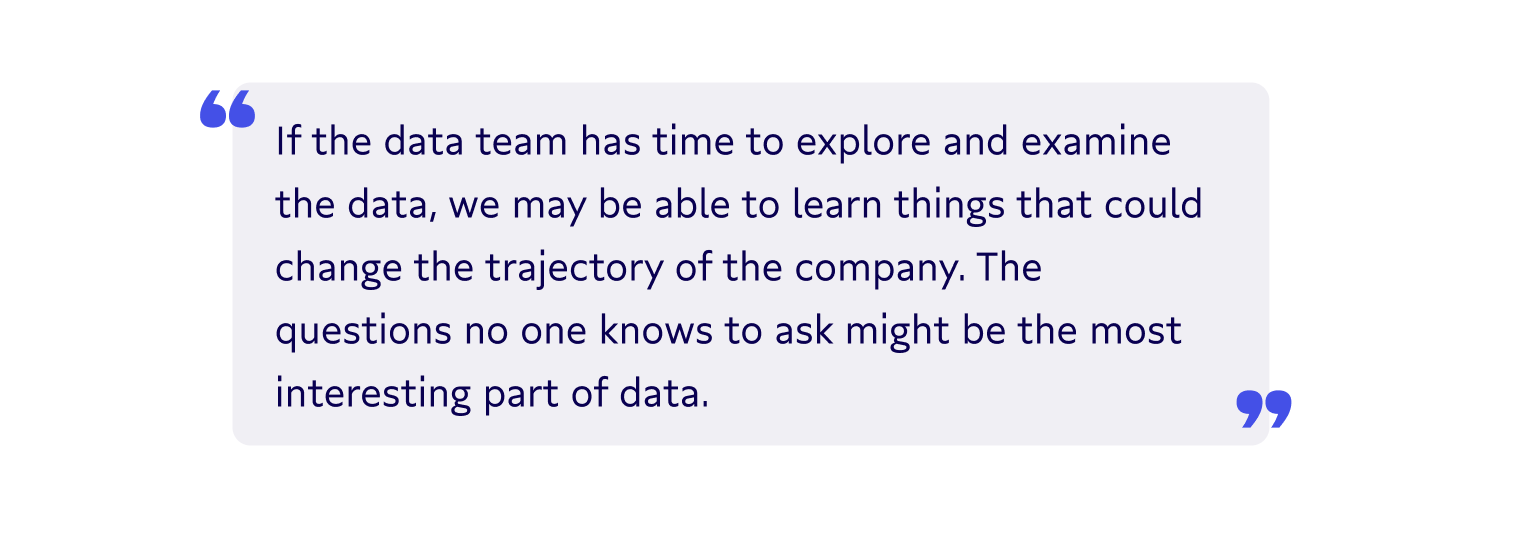As the age-old adage says, “The best-laid plans of mice and men often go awry.” And it’s true – building a plan on a massive foundation of data doesn’t make it fail-proof.
Don’t believe us? Just try talking to a few companies whose “Vision 2020” plans were demolished by COVID-19. 😷
“The presence of data gives you the false sense of confidence that you’re going to be right,” explained Barr Moses, Co-founder and CEO at Monte Carlo. “Let’s say you have the best recruiting process. You collect all the data and you follow the perfect process. You still have a one in two chance that the person you hire will be the wrong fit.”
So, if a data-driven process has the same odds of success as a coinflip… Why bother planning at all?
Because the value is in the journey, not the destination. 🧳
“Planning is nothing but planning is everything,” said Boris Jabes, Co-founder and CEO of Census. “You learn; your team learns. There are ancillary benefits.”
The value is in the planning, not the plan
While the chances of everything going to plan are slim, the very act of planning is beneficial. Take the ever-popular “X”-year plan. Whether you’re looking three, five, or ten years into the future, assuming you can predict what will happen in the future is crazy talk.
Of course, you can make guesses based on current trends, but there’s no definitive way to know when an obstacle will rear its ugly head (or what obstacle it will be, for that matter). After all, in 2017, would you have predicted the fallout of a global pandemic? 🤧
Although you can’t foresee the obstacles that might crop up several years in the future, making a plan can uncover the milestones you need to hit to meet your ultimate goals. If you don’t have any initiatives in mind, how do you know what you’re working towards?
For instance, let’s say your three-year plan is to grow your company by 50%. Plotting the course could show you when you will need to hire more people or move to a larger facility. Either way, you’ve not only identified the “what”, but also the “when.”
“The plan itself is always subject to change, and you should revisit it and examine it often,” Barr said. “But the planning process is important because it forces a couple of things.”
Planning forces you to imagine scenarios
Sure, a good plan includes a series of milestones, but it’s so much more than that. It also includes fallbacks for what you will do when obstacles force you to re-examine your roadmap. Detour, anyone?
Barr says Dwight D. Eisenhower summed the entirety of planning up perfectly when he said, “Plans are worthless but planning is everything. When you are planning for an emergency, you must start with this one thing: the very definition of an emergency is that it is unexpected, therefore it will not happen the way you are planning.”
So, we can’t know with certainty what is going to happen in the future, but planning forces us to imagine what might happen, so we can be ready to roll with whatever punches come our way. 👊
Planning helps you to take stock of your resources and rank your priorities
A plan enables prioritization, setting out an organizational goal, so all team members can orient their deliverables around it. Without a broader plan to guide them, teams tend to prioritize what matters to them rather than what matters to the company. With a solid plan in place, you have a clear picture of your available resources and can rank your priorities to match, boosting your confidence to make decisions in the field (not to mention your business value). ✅
“Left to our own devices, there is a default for data teams to set OKRs – like making sure other teams are using our platforms,” Boris said. “The right answer is, ‘If the company as a whole wants to reach this goal, what is our team’s part in that?’”
One of the common pitfalls of OKRs and KPIs is forgetting the primary goal, Barr said. It’s easy for humans to become obsessed with beating a metric just because it’s there, even if it’s a vanity metric that won’t really impact business success. 🎮 While reaching the carrot is a great short-term goal to eventually get you to the end goal, sometimes we’re so focused on the carrot that we forget about the finish line entirely.
“This happens not just in data or analytics teams, but teams in general: Focusing on things whose value is not totally clear,” Barr said. “There’s misalignment on whether this project will have an impact on the company or not.”
Leaving room to explore
Without a plan that sets priorities, a lot of time is wasted. One of the most frustrating examples is when the data team is tasked with answering a time- and labor-intensive question, only to find out it was a low-value metric that stakeholders didn’t really care about anyway. Or worse, they hustled to answer it, but then the question was changed entirely, making the once-valued answer and all endeavors moot.
Businesses could waste far less time if they actually prioritized freeform data exploration as part of their plan. Most of a data team’s time is spent putting out fires or juggling requests of varying importance, Boris said, but their greatest impact comes when they are sifting through the data for the sheer delight of it. When you’re looking for patterns no one requested, you come across the answers to high-valued questions that no one has asked. 💡
“I think it’s very hard to make an incredible impact without prioritizing – and the biggest impacts often come from time intertwined with play,” Barr said. “If the data team has time to explore and examine the data, we may be able to learn things that could change the trajectory of the company. The questions no one knows to ask might be the most interesting part of data.” 🤔

Planning for the next evolution
Planning forces a level of documentation that makes it possible for teams to pass the torch when the time comes. Only a few years ago, when data teams were smaller – and Big Data itself was not so big – documenting as we went felt like a waste of time, so it was thrown on the back burner.
Today, downtime and data issues are frequently caused by systems being handed over to new people without the definitions and documentation to make them manageable. 😧 Documenting code is easy during development – when you’re deep in the trenches – but it gets harder the longer you wait.
“In a weird way, the constraints of something like SLAs, that feel like an extra load, are actually freeing,” Boris said. “You shouldn’t want to own this forever. At some point, you should be able to go and do other things and pass the torch to someone else.”
Handoffs are an inevitable part of software engineering and software development (no one works on everything forever!), yet the same hiccups tend to happen time and time again. As a rule of thumb: when you learn something new that could be useful to others, those docs should be updated – and planning facilitates that.
Plans are living things that will grow and change as information is uncovered and events unfold. But the real value in making a plan isn’t the plan itself, it’s the process you take to get there. 🌄
Want to learn more? You can catch the full conversation between Boris and Barr below, or on your favorite streaming platforms. 🎧
Then head on over to The Operational Analytics Club to join the conversation around this and many other data best practices. ✨

















